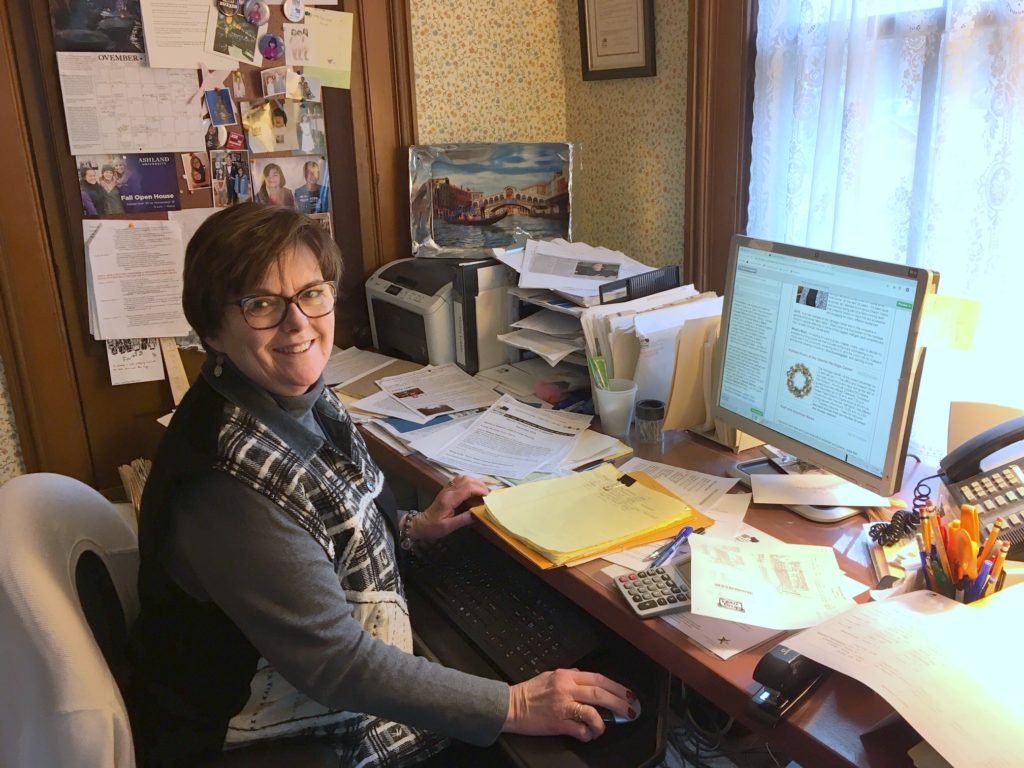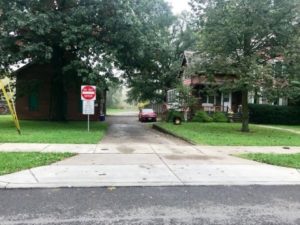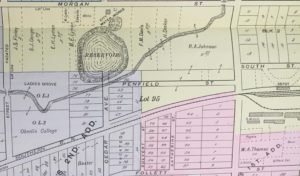Change is the only Constant in Life*
Saturday, November 30th, 2019By Assistant to the Director Mary Anne Cunningham
In 1993, Pat Murphy and I took turns working at the computer in a shared front office.
(Notice we used a folding chair at this work station in those early years!)
What a wonderful journey began when I stepped through the Monroe House’s front doors to begin working for the Heritage Center 26 years ago. It was autumn 1993 and I was hired to work 10 hours a week assisting the organization’s new Administrator Pat Murphy. Right away, I could tell from the people I met, from the local history I learned, and from the vision that Pat and the Board had for the organization, that this was going to become a special place.
There has been a remarkable amount of change here over the past quarter-of-a-century, and yet I would say that the essence of the organization remains very much the same. Among the changes:
- The Organization’s Name: A name change sounds like a quick edit on a piece of paper, but actually can represent years of careful planning, introduction and promotion. The cumbersome “Oberlin Historical & Improvement Organization” with its confusing acronym (O.H.I.O) was changed in 1998 to the more clear-cut “Oberlin Heritage Center,” and gradually through the succeeding years, the new name (along with a new logo) came to better identify the organization’s mission in the community.
- Buildings & Grounds: The years have seen a changing “footprint” to the site, both conceptually (adding the Jewett House to the historic site tour in 1994) as well as physically (moving the Little Red Schoolhouse across the lawn in 1997 to install two intersecting brick walkways that provide easy and inviting access through the grounds). Other major changes to the organization’s bricks-and-mortar composition included the transfer of ownership of the Burrell-King House to Oberlin College & Conservatory for use as a new Community Music School (2003) and purchasing the Vineway building to develop access and visibility for the Heritage Center from Main Street (2010).
- Staff Growth: The Heritage Center staff has grown from two part-time jacks-of-all-trades employees (1993) to a balanced team with particular expertise and job responsibilities including a part-time Collections Manager (added in 1998); part-time Business Manager (1998); and full-time Museum Education & Tour Coordinator (2007). The Administrator position became a full-time Executive Director in 1999. My role as part-time Assistant to the Director will be even better defined in my successor’s job title when the new Communications & Development Coordinator joins the staff next month. Meet Veronica Vanden Bout in January’s E-Gazette!
- Technological Advancement: When I arrived at the Heritage Center, there was one shared computer (and one typewriter!), Pat Murphy and I shared one office (the front reception area), and we walked uptown each day to the Co-Op Bookstore to use its photocopying machine. We didn’t think much of these “limitations,” as this was pretty much the norm at that time. The rapid development of technology since then has vastly increased the organization’s capacity to connect with members and friends through ever-new options in database management and communications methods. Local history is now much more accessible to broader audiences through OHC’s website and Facebook/Instagram pages, while we now also can adapt tours and outreach for different learning preferences, including docent-led tours, self-guided tablet tours, interactive smart phone tours or hands-on-history classroom learning kits. Technology also has provided opportunities for staff to become more knowledgeable about their own work through professional development webinars, online support communities, skyping and more. Workplace changes in general over the past 25 years have been amazing, and have allowed small nonprofits like OHC the ability to do so much more with limited staff and resources.
- National Accreditation: Those early years passed quickly as staff and volunteers developed policies and procedures in all areas of museum management, created a strategic plan to provide a roadmap for the future, and worked together to document, record, conserve, interpret, and follow best practices of museum operations. In 2005, after a long, rigorous process of self-study and peer review, the Heritage Center was accredited by the American Alliance of Museums. This mark of distinction placed the Oberlin Heritage Center in the top ten percent of museums operating in the United States – this was indeed a pivotal moment in the organization’s history. The accreditation process needs to be re-visited periodically, and in 2020 the Heritage Center will be working through the steps for re-accreditation … stayed tuned for more in coming months.
We’ve all heard the saying the more things change, the more they stay the same. In many ways, the fundamental nature of the organization remains much the same as I found it in 1993:
- It’s a Membership Organization: Oberlin Heritage Center members have long been the heart of the organization – OHC couldn’t do what it does without the support, participation, encouragement and feedback of its members. Membership in 1993 totaled about a dozen individuals and couples; it has grown a lot since then and in recent years, OHC has maintained a stable membership of about 700 households and businesses. Nothing makes me smile more than welcoming new members to the organization — even after 26 years, I still do a “happy dance” when someone new joins the Heritage Center
- Tours: Guided tours have been a hallmark of the Heritage Center’s educational offerings even when the organization was an all-volunteer group prior to 1993; tour fees continue to remain very affordable to this day.
- Educational Programs: The vast majority of public history programs that the Heritage Center presents in the community are free of charge. Programs that require a fee are kept as low-cost as possible, and OHC members typically receive a discount. Children’s camps and outreach activities are further supported by scholarships and grant assistance. Making history education accessible and affordable has been a consistent principle of the organization’s mission.
- Beautifully preserved historic buildings: The Monroe House, Little Red Schoolhouse and Jewett House are enduring and distinguishing features of the Oberlin Heritage Center. Being able to appropriately care for these buildings and the artifacts within them has been a top priority since day one.
- Volunteers: If members are the heart of the organization as stated earlier, then volunteers have to be considered the backbone. For nine decades, the organization’s leadership and momentum depended solely on volunteers – a fact I have always appreciated and applauded! Since 1993, when an outside grant to the organization allowed professional staff to be hired for the first time, the dedication and expertise of volunteers continued to be the Heritage Center’s greatest resources. Without a doubt, the Heritage Center would not be the organization it is today without the tremendous commitment of more than a century of volunteer leadership and participation.
I hope you share some of my great love for the Oberlin Heritage Center – as a caring and careful preserver of Oberlin’s past, as an organization that brings people together and instills pride in their community, and as an educational resource that encourages new generations to explore and enjoy local history. Thank you to everyone who has supported the Heritage Center during these past 26 years – you’ve made it an exciting, fun, challenging and unforgettable experience for me every step of the way!
*This contemplative quote is attributed to ancient Greek philosopher Heraclitus.
Since 2000, this cozy corner in a second floor office (shared with two other staff members) is what I like to call my “nest.” You can see that I like to line it with plenty of paper and I have a bird’s eye view of the grounds from the beautiful window facing me!




























